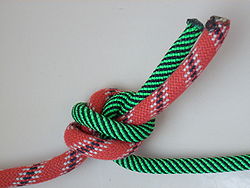Sack stitch
| Sack stitch (teardrop shape) | |
|---|---|

|
|
| Type | connection |
| application | |
| Ashley No. | 1410 |
| English | Overhand Bend, Thumb Knot, European Death Knot |
| List of nodes | |
The sack stitch is a connecting knot based on the overhand knot , which is quick and easy to tie.

- teardrop shape (left)
- ring shape (middle)
- loop (right)
opposite the figure eight knot (back)
application
The sack stitch is used to create a quick and easy connection between two ropes or as a loop. The knot strength is better in the ring shape than in the teardrop shape. For example, at a 5-mm Cord from Dyneema compared to only 28% in a ring form 33%, in the form of drops; with 4.5 mm made of Kevlar it is 53% compared to 38%. The sack stitch can hardly be loosened after exercise.
When rappelling with a double rope, mountaineers often use this teardrop-shaped knot. It is easy to control and rarely gets stuck in a crevice when it is pulled. Since the forces are relatively low compared to the tensile strength of the rope, the knot strength plays a subordinate role. It can also be used with ropes of different thicknesses. Even if the knot is nicknamed European Death Knot in American English , it is still considered a reliable knot for connecting two climbing ropes.
The sack stitch in teardrop shape slips particularly well through a snap hook , as it is smooth on one side. As a short endless loop , it can also be placed as a knot loop in a crevice and thus serve as a provisional securing point.
Knot
Teardrop shape
For the drop-shaped variation of the sack stitch, the two rope ends are laid next to each other. Then an overhand knot is tied with the double rope . The knot must be tightened well and the loose end should be at least ten times the diameter of the rope (see illustration). Excessively long rope ends offer no advantages, only the risk of being entangled.
Ring shape
To tie this shape, the knot must be tied. A loose overhand knot is tied into one end of the rope. With the other end of the rope you go exactly in the opposite direction parallel to the first one.
The ring shape was previously used to knot ribbon loops from yard goods and is called ribbon loop knot in this application . Because of security risks, it is also called the death knot and is no longer used.
Modifications
When tied as a loop , the knot is also called a sack stitch by climbers. Swiss mountaineers also call it the “guide knot”. However, it is not suitable for roping up in two-person ropes because it offers no redundancy and cannot be opened after a fall. For this purpose, it can only be found on top rope ropes in climbing halls, where opening is not desired. When going on glaciers, however, the middle man can use the knot as a rope knot. It is also used when roping up with a chest strap. It also serves as a stopper at the end of the rope as an alternative to the eight knot .
Alternatives
A figure eight knot can be loosened more easily as a rope connection after loading. In teardrop form, however, it is not recommended for abseiling because it rolls at 2 kN. There have been accidents with this application. Even in a ring shape it is inferior to the sack stitch because it tends to get stuck in crevices due to the larger knot shape. Climbers use the figure eight knot as a loop to rope up .
The package knot has a significantly higher knot strength than the sack stitch, but is a little more difficult to knot and has a more complex knot pattern.
Very safe connections even with slippery ropes can be achieved with spar stitch , double spar stitch and Zeppelinstek . They are also very easy to solve.
The Trossenstek is suitable for thick cables .
The Schotstek connects ropes very reliably and can be released easily. However, if the rope is not constantly under load, it can loosen itself.
Individual evidence
- ↑ Chris Semmel: So check who binds . In: Panorama . No. 4 , 2007, p. 76–79 ( full text [PDF; accessed April 2, 2020]).
- ↑ a b Christiane Nastarowitz-Bien: Only abseiling? About the pitfalls of "coming back down" (Part 2). In: Berliner Bergsteiger . No. 5 , 2007, p. 10–11 ( PDF 345 kB [accessed March 15, 2019]).
- ↑ Chris Semmel: Small knot knowledge for the Alpine. June 18, 2017, accessed March 15, 2019 .
- ↑ a b The Euro Death Knot. In: American Alpine Institute - Climbing Blog. March 9, 2009, accessed March 15, 2019 .
- ↑ Clifford W. Ashley: The Ashley Book of Knots . Edition Maritim, Hamburg 1999, ISBN 3-922117-37-6 , # 1412, p. 269 .
- ↑ Walter Siebert: Let's wait a few more deaths . In: mountaineering . No. 2 , 2007, p. 6 ( PDF [accessed April 16, 2015]).
- ↑ Bernd Eberle: Who else falls into the column . In: Panorama . No. 4 , 2014, p. 54–57 ( PDF [accessed March 15, 2019]).
- ↑ Karl Schrag: Roping and tying in while climbing . In: Panorama . No. 4 , 2000, pp. 66 ( PDF [accessed March 15, 2019]).
- ↑ Chris Semmel: Downwards - but safely . In: Panorama . No. 3 , 2008, p. 75-77 ( PDF [accessed March 15, 2019]).
- ↑ Knots for Rappelling. In: American Alpine Institute. February 3, 2017, accessed April 14, 2020 .



